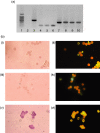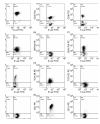Expression of 5-lipoxygenase (5-LOX) in T lymphocytes
- PMID: 17484769
- PMCID: PMC2265994
- DOI: 10.1111/j.1365-2567.2007.02621.x
Expression of 5-lipoxygenase (5-LOX) in T lymphocytes
Abstract
5-Lipoxygenase (5-LOX) is the key enzyme responsible for the synthesis of the biologically active leukotrienes. Its presence has been reported in cells of the myeloid lineage and B lymphocytes but has not been formally defined in T lymphocytes. In this study, we provide evidence for 5-LOX expression on both transcriptional and translational levels in highly purified peripheral blood T cells as well as in human T lymphoblastoid cell lines (MOLT4 and Jurkat). Messenger RNA (mRNA) of 5-LOX was amplified by conventional reverse transcription-polymerase chain reaction (RT-PCR; MOLT4 and Jurkat cells) and by in situ RT-PCR (T lymphocytes). 5-LOX protein expression was confirmed by Western blot and immunofluorescence studies. 5-LOX was present primarily in the cytoplasm with some nuclear localization and was translocated to the nuclear periphery after culture in a mitosis-supporting medium. Fluorescence-activated cell sorter analysis of different T-lymphocyte populations, including CD4, CD8, CD45RO, CD45RA, T helper type 2, and T-cell receptor-alphabeta and -gammadelta expressing cells, did not identify a differential distribution of the enzyme. Purified peripheral blood T lymphocytes were incapable of synthesizing leukotrienes in the absence of exogenous arachidonic acid. Jurkat cells produced leukotriene C(4) and a small amount of leukotriene B(4) in response to CD3-CD28 cross-linking. This synthesis was abolished by two inhibitors of leukotriene synthesis, MK-886 and AA-861. The presence of 5-LOX in T lymphocytes but the absence of endogenous lipoxygenase metabolite production compared to Jurkat cells may constitute a fundamental difference between resting peripheral lymphocytes and leukaemic cells.
Figures




Similar articles
-
Comparative gene expression by WC1+ gammadelta and CD4+ alphabeta T lymphocytes, which respond to Anaplasma marginale, demonstrates higher expression of chemokines and other myeloid cell-associated genes by WC1+ gammadelta T cells.J Leukoc Biol. 2006 Oct;80(4):939-52. doi: 10.1189/jlb.0506353. J Leukoc Biol. 2006. PMID: 17005908
-
Evidence of 5-lipoxygenase overexpression in the skin of patients with systemic sclerosis: a newly identified pathway to skin inflammation in systemic sclerosis.Arthritis Rheum. 2001 Aug;44(8):1865-75. doi: 10.1002/1529-0131(200108)44:8<1865::AID-ART325>3.0.CO;2-M. Arthritis Rheum. 2001. PMID: 11508440
-
Overexpression of 5-lipoxygenase in colon polyps and cancer and the effect of 5-LOX inhibitors in vitro and in a murine model.Clin Cancer Res. 2008 Oct 15;14(20):6525-30. doi: 10.1158/1078-0432.CCR-07-4631. Clin Cancer Res. 2008. PMID: 18927292
-
Nuclear import of arachidonate 5-lipoxygenase.Arch Immunol Ther Exp (Warsz). 2000;48(6):481-6. Arch Immunol Ther Exp (Warsz). 2000. PMID: 11197602 Review.
-
5-lipoxygenase mRNA and protein isoforms.Basic Clin Pharmacol Toxicol. 2014 Jan;114(1):78-82. doi: 10.1111/bcpt.12115. Epub 2013 Sep 10. Basic Clin Pharmacol Toxicol. 2014. PMID: 24020397 Review.
Cited by
-
5-Lipoxygenase-mediated endogenous DNA damage.J Biol Chem. 2009 Jun 19;284(25):16799-16807. doi: 10.1074/jbc.M109.011841. Epub 2009 Apr 23. J Biol Chem. 2009. PMID: 19390118 Free PMC article.
-
High expression of 5-lipoxygenase in normal and malignant mantle zone B lymphocytes.BMC Immunol. 2009 Jan 9;10:2. doi: 10.1186/1471-2172-10-2. BMC Immunol. 2009. PMID: 19134178 Free PMC article.
-
Proinflammatory and immunoregulatory roles of eicosanoids in T cells.Front Immunol. 2013 Jun 4;4:130. doi: 10.3389/fimmu.2013.00130. eCollection 2013. Front Immunol. 2013. PMID: 23760108 Free PMC article.
-
Elevated Levels of Anti-Inflammatory Eicosanoids and Monocyte Heterogeneity in Mycobacterium tuberculosis Infection and Disease.Front Immunol. 2020 Nov 12;11:579849. doi: 10.3389/fimmu.2020.579849. eCollection 2020. Front Immunol. 2020. PMID: 33304347 Free PMC article.
-
Polyunsaturated Fatty Acid-derived lipid mediators and T cell function.Front Immunol. 2014 Feb 25;5:75. doi: 10.3389/fimmu.2014.00075. eCollection 2014. Front Immunol. 2014. PMID: 24611066 Free PMC article. Review.
References
-
- Funk CD. Prostaglandins and leukotrienes: advances in eicosanoid biology. Science. 2001;294:1871–5. - PubMed
-
- Ruegg C, Dormond O, Mariotti A. Endothelial cell integrins and COX-2: mediators and therapeutic targets of tumor angiogenesis. Biochim Biophys Acta. 2004;1654:51–67. - PubMed
-
- Goodwin JS, Ceuppens J. Regulation of the immune response by prostaglandins. J Clin Immunol. 1983;3:295–315. - PubMed
-
- Stjernschantz J. The leukotrienes. Med Biol. 1984;62:215–30. - PubMed
-
- Rouzer CA, Kargman S. Translocation of 5-lipoxygenase to the membrane in human leukocytes challenged with ionophore A23187. J Biol Chem. 1988;263:10980–8. - PubMed
MeSH terms
Substances
LinkOut - more resources
Full Text Sources
Research Materials
Miscellaneous

